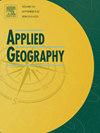Emerging amenity migration in China: The spatially heterogeneous process
IF 4
2区 地球科学
Q1 GEOGRAPHY
引用次数: 0
Abstract
Amenity plays a crucial role in determining migration patterns but varies with development stages and different regions. While amenity migration, namely migration dominated by amenity factors, has been widely identified in developed countries with numerous case studies, the question of the extent to which amenity shapes migration patterns in developing countries, especially concerning the spatiotemporal heterogeneity, is less well answered. To address this gap, the paper takes China as a case to examine spatiotemporally varying roles of amenities in affecting migration patterns. The results of panel model and cross-sectional regressions showed increasing effects of amenities with upgrading development stages, while the effects of economic opportunities are weakened, indicating an emerging trend of amenity migration. The results of the multiscale geographically weighted regression model further confirmed the varying effects of various amenities in different regions. The specific roles of amenities depend on the local context. In addition, migration patterns are influenced by different dominant factors in different places. While the impact of economic opportunities on migration is important in less economically developed regions, the impact of place-specific amenity is even more important in economically developed regions. Finally, migration transition arising from changes in migration dynamics and its spatially heterogeneous processes were discussed.
中国新兴舒适性迁移:空间异质性过程
适宜性在决定迁移模式中起着至关重要的作用,但随着发展阶段和不同地区的不同而有所不同。虽然发达国家已通过大量案例研究广泛确定了以舒适因素为主的舒适移民,但关于舒适在多大程度上影响发展中国家的移民模式,特别是涉及到时空异质性的问题,尚未得到很好的回答。为了解决这一差距,本文以中国为例,考察了便利设施在影响迁移模式中的时空变化作用。面板模型和横断面回归结果显示,随着发展阶段的升级,便利设施的影响逐渐增强,而经济机会的影响逐渐减弱,表明便利设施迁移的趋势正在显现。多尺度地理加权回归模型的结果进一步证实了各种便利设施在不同区域的不同影响。设施的具体作用取决于当地的环境。此外,不同地区的迁移模式受不同主导因素的影响。虽然经济机会对移徙的影响在经济不发达区域很重要,但在经济发达区域,特定地点的便利设施的影响更为重要。最后,讨论了迁移动态变化引起的迁移过渡及其空间异质性过程。
本文章由计算机程序翻译,如有差异,请以英文原文为准。
求助全文
约1分钟内获得全文
求助全文
来源期刊

Applied Geography
GEOGRAPHY-
CiteScore
8.00
自引率
2.00%
发文量
134
期刊介绍:
Applied Geography is a journal devoted to the publication of research which utilizes geographic approaches (human, physical, nature-society and GIScience) to resolve human problems that have a spatial dimension. These problems may be related to the assessment, management and allocation of the world physical and/or human resources. The underlying rationale of the journal is that only through a clear understanding of the relevant societal, physical, and coupled natural-humans systems can we resolve such problems. Papers are invited on any theme involving the application of geographical theory and methodology in the resolution of human problems.
 求助内容:
求助内容: 应助结果提醒方式:
应助结果提醒方式:


